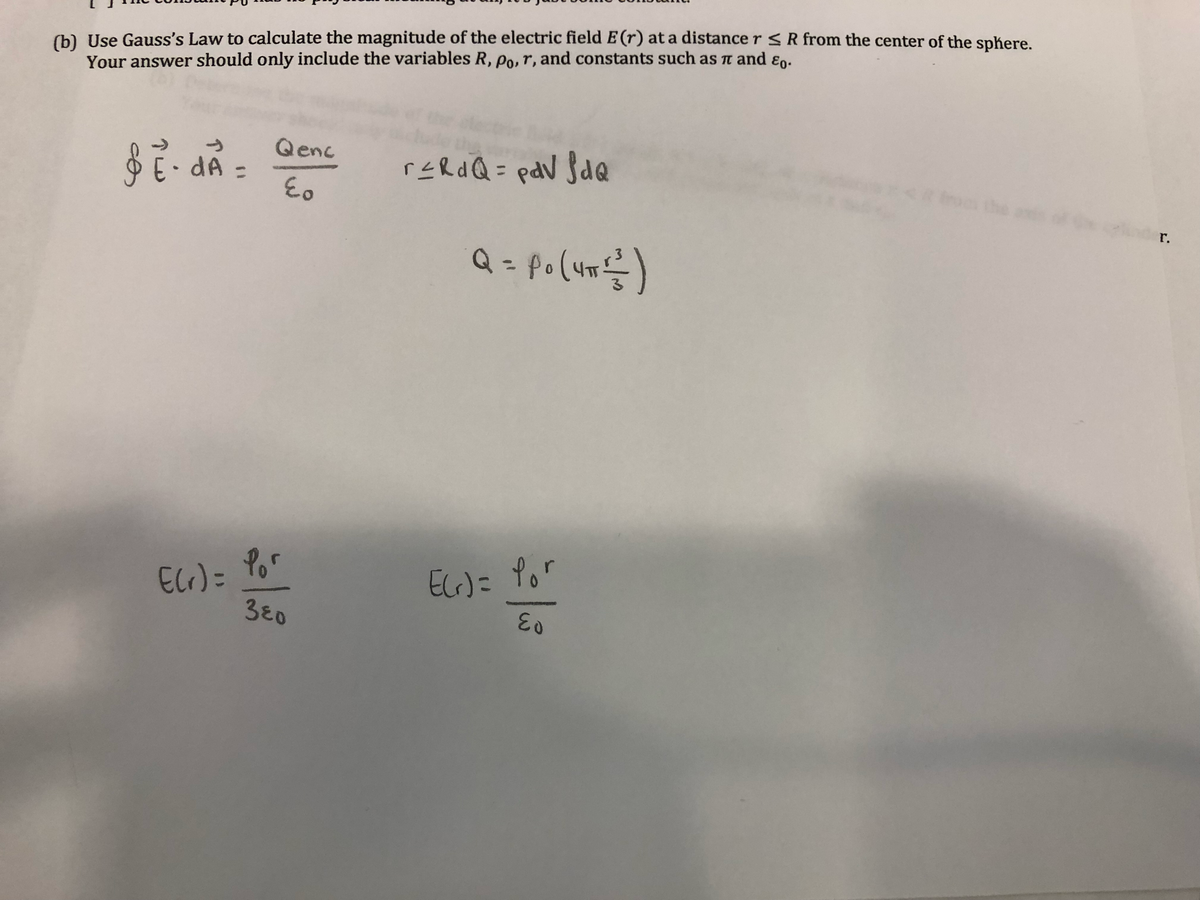A solid sphere of radius R has a charge density given by p(r) = Po r/R. Here r is the distance from the center of the sphere, and po is a constant with units C/m3. (a) What is the physical meaning of po ? [ ] It's the charge density at the center of the sphere, i.e. atr = 0. [ ] It's the charge density on the surface of the sphere, i.e. at r R. [ ] It's the average charge density of the sphere. [ ]The constant po has no physical meaning at all, it's just some constant. (b) Use Gauss's Law to calculate the magnitude of the electric field E(r) at a distance r < R from the center of the sphere. Your answer should only include the variables R, Po, r, and constants such as n and ɛp.
A solid sphere of radius R has a charge density given by p(r) = Po r/R. Here r is the distance from the center of the sphere, and po is a constant with units C/m3. (a) What is the physical meaning of po ? [ ] It's the charge density at the center of the sphere, i.e. atr = 0. [ ] It's the charge density on the surface of the sphere, i.e. at r R. [ ] It's the average charge density of the sphere. [ ]The constant po has no physical meaning at all, it's just some constant. (b) Use Gauss's Law to calculate the magnitude of the electric field E(r) at a distance r < R from the center of the sphere. Your answer should only include the variables R, Po, r, and constants such as n and ɛp.
Chapter6: Gauss's Law
Section: Chapter Questions
Problem 55P: The electric field 10.0 cm from the surface of a copper ball of radius 5.0 cm is directed toward the...
Related questions
Question
100%
Can someone help me with this question? I've somewhat started it off, but I don't know if I'm heading in the right direction. I've attached pictures of my work and a the question itself below. I appreciate the help! Thank you.
![A solid sphere of radius R has a charge density given by p(r) = Po r/R. Here r is the distance from the center of the sphere,
and po is a constant with units C/m3.
(a) What is the physical meaning of po ?
[ ]It's the charge density at the center of the sphere, i.e. at r = 0.
[ ]It's the charge density on the surface of the sphere, i.e. at r = R.
[ ]It's the average charge density of the sphere.
[ ]The constant po has no physical meaning at all, it's just some constant.
(b) Use Gauss's Law to calculate the magnitude of the electric field E (r) at a distance r < R from the center of the sphere.
Your answer should only include the variables R, po, r, and constants such as Tt and ɛ0.](/v2/_next/image?url=https%3A%2F%2Fcontent.bartleby.com%2Fqna-images%2Fquestion%2Fdff826c2-1340-4198-8b48-1dc7e886b6b0%2F736a5017-8df1-43aa-b91c-ee1bb091f86a%2F45kpir6_processed.jpeg&w=3840&q=75)
Transcribed Image Text:A solid sphere of radius R has a charge density given by p(r) = Po r/R. Here r is the distance from the center of the sphere,
and po is a constant with units C/m3.
(a) What is the physical meaning of po ?
[ ]It's the charge density at the center of the sphere, i.e. at r = 0.
[ ]It's the charge density on the surface of the sphere, i.e. at r = R.
[ ]It's the average charge density of the sphere.
[ ]The constant po has no physical meaning at all, it's just some constant.
(b) Use Gauss's Law to calculate the magnitude of the electric field E (r) at a distance r < R from the center of the sphere.
Your answer should only include the variables R, po, r, and constants such as Tt and ɛ0.

Transcribed Image Text:(b) Use Gauss's Law to calculate the magnitude of the electric field E (r) at a distance r R from the center of the sphere.
Your answer should only include the variables R, po,r, and constants such as Tn and ɛn.
Qenc
E dA =
reRdQ= pdV $dQ
0 the
r.
Q = po(um)
ECr)= Por
3 0
EcG)= Yor
Expert Solution
Step 1
a.)
[ ] It's the charge density on the surface of the sphere, i.e. at r = R
Trending now
This is a popular solution!
Step by step
Solved in 2 steps with 1 images

Knowledge Booster
Learn more about
Need a deep-dive on the concept behind this application? Look no further. Learn more about this topic, physics and related others by exploring similar questions and additional content below.Recommended textbooks for you


Principles of Physics: A Calculus-Based Text
Physics
ISBN:
9781133104261
Author:
Raymond A. Serway, John W. Jewett
Publisher:
Cengage Learning

College Physics
Physics
ISBN:
9781285737027
Author:
Raymond A. Serway, Chris Vuille
Publisher:
Cengage Learning


Principles of Physics: A Calculus-Based Text
Physics
ISBN:
9781133104261
Author:
Raymond A. Serway, John W. Jewett
Publisher:
Cengage Learning

College Physics
Physics
ISBN:
9781285737027
Author:
Raymond A. Serway, Chris Vuille
Publisher:
Cengage Learning